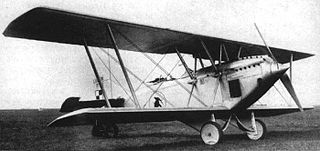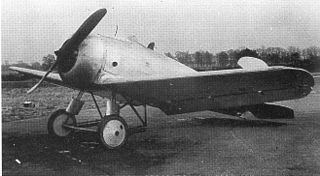Related Research Articles

The Sopwith T.1 Cuckoo was a British biplane torpedo bomber used by the Royal Naval Air Service (RNAS), and its successor organization, the Royal Air Force (RAF). The T.1 was the first landplane specifically designed for carrier operations, but it was completed too late for service in the First World War. After the Armistice, the T.1 was named the Cuckoo.

The Bristol F.2 Fighter was a British two-seat biplane fighter and reconnaissance aircraft of the First World War developed by Frank Barnwell at the Bristol Aeroplane Company. It is often simply called the Bristol Fighter, other popular names include the "Brisfit" or "Biff".

The Lublin R-VIII was a Polish bomber, reconnaissance aircraft and seaplane designed in the late 1920s by the Plage i Laśkiewicz factory in Lublin. It was the first in-house design of Plage i Laśkiewicz, and the first with the name Lublin.

The Sopwith 5F.1 Dolphin was a British fighter aircraft manufactured by the Sopwith Aviation Company. It was used by the Royal Flying Corps and its successor, the Royal Air Force, during the First World War. The Dolphin entered service on the Western Front in early 1918 and proved to be a formidable fighter. The aircraft was not retained in the postwar inventory and was retired shortly after the war.

The Short Bomber was a British two-seat long-range reconnaissance, bombing and torpedo-carrying aircraft designed by Short Brothers as a land-based development of the very successful Short Type 184.

The Douglas T2D was an American twin-engined torpedo bomber contracted by the military, and required to be usable on wheels or floats, and operating from aircraft carriers. It was the first twin-engined aircraft to be operated from an aircraft carrier.

The Parnall Panther was a British carrier based spotter and reconnaissance aircraft designed and developed by Parnall and Sons in the latter years of World War I, continuing in service until 1926. A total of 150 Panthers were built by Bristol Aeroplane Company since after the end of World War I Parnall had stopped aircraft manufacture.

The Vickers Vendace was a 1920s British trainer aircraft. It was originally designed as a floatplane trainer for the Royal Air Force.
The Supermarine Baby was a British flying boat fighter aircraft of the First World War designed and built by the Supermarine Aviation Works. Although only one was built, it formed the basis for the later Sea King fighter and Sea Lion I racer.

The Handley Page Hanley was a British torpedo bomber aircraft of the 1920s. A single-engine, single-seat biplane intended to operate from the Royal Navy's aircraft carriers, it was not successful, with only three aircraft being built.

The Potez 39 was a French two-seat single-engined parasol wing monoplane reconnaissance and observation aircraft of the 1930s.
The Sopwith B.1 was an experimental British bomber aircraft of the First World War. A single-seat, single-engined biplane, the B.1 was built by the Sopwith Aviation Company for the Royal Navy. Although only two were built, one was used for bombing raids over France.
The Grain Griffin was a British carrier-based reconnaissance aircraft developed and built by the RNAS Marine Experimental Depot, Port Victoria, during the First World War. A development of the unsuccessful Sopwith B.1 bomber, the Grain Griffin was a two-seat single-engined biplane that was built in small numbers for Britain's Royal Naval Air Service, being used operationally during the British intervention in the Russian Civil War.

The Handley Page Type S, or HPS-1 was a prototype British carrier-based fighter developed for the United States Navy in the early 1920s. A low-wing monoplane, it was unsuccessful, only two being built and flown.

The Handley Page H.P.31 was a two-seat single-engined biplane built to a British specification for a carrier-based torpedo bomber and reconnaissance aircraft. After trials, the Blackburn Ripon was preferred, though the Harrow played a significant role in the development of automatic slots.

The Yokosuka Ro-go Ko-gata was a Japanese reconnaissance floatplane developed during the First World War by the Japanese Navy Arsenal at Yokosuka, and one of the first indigenous Japanese aircraft to enter production. There were 218 of these aircraft built for the Imperial Japanese Navy, which remained in use until 1928.
The Borel-Odier Bo-T was a French twin-engined float biplane designed by Borel but built by Antoine Odier for the French Navy.

The Hispano Suiza E-30, later renamed Hispano E-30, was designed in Spain in 1930 as a multi-purpose intermediate trainer. It was a single engine, parasol wing monoplane. About 25 served with the Spanish armed forces until 1945.
The Sage Type 4 was a prototype British floatplane of the First World War. It was a designed as a two-seat reconnaissance aircraft for the Royal Naval Air Service, but was chosen for service as a floatplane trainer, although the end of the war resulted in production being cancelled.
The Port Victoria P.V.5 was a British single-engined floatplane fighter aircraft of the First World War. A single example was built and flown at the Royal Naval Air Service's Port Victoria Marine Experimental Aircraft Depot on the Isle of Grain in 1917. Despite demonstrating good manoeuvrability and handling, no production followed, with the Royal Naval Air Service instead using landplanes for the fighter role.
References
- Barnes, C. H. Handley Page Aircraft Since 1907. London: Putnam, 1976. ISBN 0-370-00030-7.
- Bruce, J.M. British Aeroplanes 1914–18. London:Putnam, 1957.